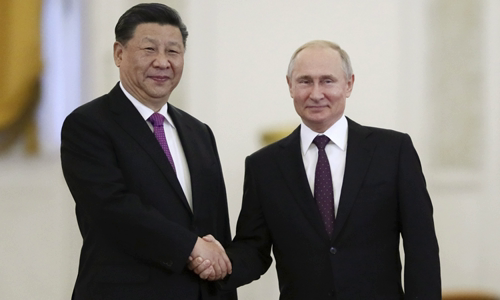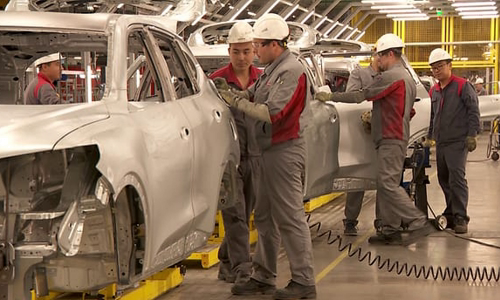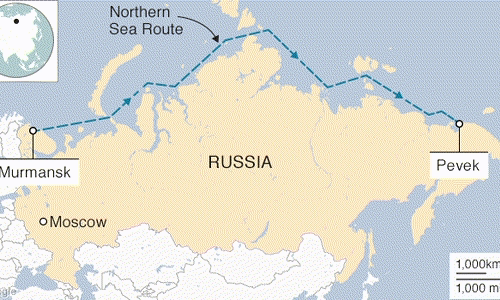Nearly three decades after the Cold War, the two former Russian and Chinese allies "warmed up" when Beijing and Washington were strained.
In order to strengthen the relationship that the two sides consider to be "strategic", Russia and China have embarked on many major projects, organizing joint drills, seemingly aiming to establish a united "front" against back to American protectionism under President Donald Trump.

Chinese President Xi Jinping (left) shakes hands with Russian President Vladimir Putin in the Kremlin, Moscow on June 5. Photo: Reuters
According to CNA commentators Derrick A Paulo and Charles Phang, recent Russian and Chinese moves illustrate the fact that Beijing does not just consider Moscow as a trading partner. From efforts to prevent the effects of the trade war to conquering the Arctic together, the scale of cooperation between China and Russia is wide enough to cause Western concern.
One of the policies that promote relations with Russia that China uses is "panda diplomacy". In late April, Ru Yi and Ding Ding, two large pandas that China lent to Russia within 15 years, were taken to Moscow Zoo. Russian President Vladimir Putin considered the gift "a gesture of showing special respect and trust in Russia". "When it comes to pandas, we always smile. We accept this gift with deep respect and gratitude," the Kremlin boss said on June 5.
Moscow Zoo has to pay China about one million dollars a year, not including the money needed to build living space and import bamboo as food for the two pandas. However, zoo director Moskva Svetlana Akulova said the cost was not a concern. "This is not a financial project, but a scientific research collaboration between China and Russia in this area," she explained.
Commentators Paulo and Phang assess the Russian reception of Chinese pandas reflecting the close relationship between Moscow and Beijing recently.
This cohesion also manifests itself in the areas of investment, trade and employment. In the Russian industrial city of Tula, where local authorities are trying to turn into a manufacturing center, abundant labor and land have attracted Great Wall Motors, the maker of sports utility vehicles (SUVs). ) China's largest, building an automobile factory.
At a cost of US $ 500 million, it is China's largest investment project in the Russian manufacturing industry, and is China's first overseas auto factory that the vehicle was assembled in the first place. The factory opened in June, applying some of China's latest manufacturing technologies, such as high-tech assembly robots, which are expected to generate a total product value of about $ 2.6 billion.
"The local government gives us very good incentives that are hard to refuse such as tax breaks, recruitment assistance, or business development as well as the production of high quality products. , we are grateful to them, "said factory vice president Ivan Dushkin.
More than 1,000 workers have received jobs, with 90% of them residing in the Tula region, western Russia. It is estimated that productivity next year will increase from 80,000 to 150,000 cars / year. Despite the high degree of automation, assembly engineer Ivan Martynenko is confident that skilled workers like him are valued. He also wants to learn more from Chinese experts.
The Russia-China Commercial Area in St Petersburg, the second largest city in the country, is also helping other Chinese companies to expand their operations in Russia, giving momentum to the Belt and Road Initiative. However, unlike industrial parks along China's "new silk road," there are exhibition halls for innovation instead of offices or factories. Its core purpose is to focus on promoting multicultural understanding.
Russian tourists can experience a variety of Chinese arts such as calligraphy, music, martial arts or tea. Meanwhile, Chinese laborers in the city can learn Russian through opera.

Workers at the Great Wall Motors automobile factory in Tula, Russia Photo: CNA
"Our relations with Russia are improving not only in the field of commerce, but also through cultural exchanges. We use culture as a bridge between companies from both countries and provide them. comprehensive services, "said the president of the Russian-Chinese Commercial Area Chen Zhi Gang, adding that it receives between 200 and 250 Chinese businesses each year, with many successful joint business projects between the two. country.
While cooperative efforts in the Russia-China Central Business District have been largely driven by privatization, the two governments have also committed to opening a new era in bilateral relations in the context of a trade war between Washington and North. Kinh escalated.
"From Russia's point of view, the United States has broken international rules and violated the law by using economic and political tools to advance its own interests," Professor Lukonin said. "Therefore, Moscow decided to support Beijing against Washington's policy."
The support is clearly shown in the movements of Moscow. After the US-China trade talks stalemate and China has had to find alternative meat sources in recent months, Russia has quickly "reached out". Cherkizovo, Russia's largest meat producer, began exporting products to China in May and was tasked with supplying at least 48,000 tons of meat to the country by next year.
When President Trump declared a "ban" on Chinese telecommunications conglomerate Huawei for espionage, Russia still welcomed the company to develop a 5G network for them. "Huawei's cooperation with MTS, Russia's leading telecommunications company, proves that cooperation with China is beneficial for Russian companies," Professor Lukonin said.
He added that even if Washington is softer with Beijing, the relationship between Beijing and Moscow is unlikely to be weakened. "China will continue to cooperate with Russia because we are strategic partners. I think there will be no change," the professor said.
According to commentators Paulo and Phang, Russia's geography also makes it the "bridge" that China needs to connect the Arctic and the Eurasian continent with the "new silk road".
Transport companies and energy companies of the two countries are cooperating to exploit and export liquefied natural gas (LNG) from the Arctic region of Russia. Most of this gas comes from the Yamal Peninsula, which stores more than a fifth of Russia's natural gas reserves. China owns nearly 30% of a LNG plant on the peninsula, estimated to be able to produce 70 million tons of natural gas per year by 2030.
This is just one of several projects Beijing has implemented in the Arctic, including expeditions, research centers or icebreakers. They are part of the strategy to develop the "Silk Road" in the polar regions and control the North Sea Route. Maritime corridors along Russia's northern coast have recently become more accessible due to climate change. In addition, warm ties with Moscow have boosted Beijing's ambition.
"Russia recognizes that China's strategy will support its own plans to regulate shipping and shipping along the North Sea Route," Professor Lukonin explained. "The main problem here is that Russia cannot afford to do it alone, so it is extremely interested in Chinese investments to develop the North Sea Route."

North Sea route in northern Russia Photo: BBC
North Sea route in northern Russia. Graphics: BBC.
Russia and China are also increasing military cooperation with regular joint exercises, including Vostok drills last year. With about 300,000 soldiers and thousands of military aircraft and vehicles, this is the largest exercise since the Cold War, held in five land-based athletes, as well as areas in the Sea of Japan and the sea. Bering and the Sea of Okhotsk.
In celebration of the 323th anniversary of the Russian Navy's traditional navy in St Petersburg in July, a Chinese missile destroyer was among the few foreign ships engaged in parades. In recent years, Russia has also equipped China with some modern weapons.
These developments are believed to mark a turning point in geopolitics, as the two countries once faced a military expansion of cooperation from economy to defense. The West began to worry about the risk of Russia and China forming a geopolitical bloc by combining the Eurasian Economic Union, including Russia, Armenia, Belarus, Kazakhstan and Kyrgyzstan, with countries included in the Rim Initiative. Belt and Road.
However, according to Dr. Cui Hongjian, head of the European research agency at the China International Research Institute, Beijing needs to consider how to maintain a balance between the various partnerships. "Russia and China are expected to join together, while some other countries, such as the US and Europe, will belong to another coalition. This means more confrontation," he said. talk.
"I think this is a tragedy. We don't want to go back to the Cold War era, so we need to try every way to prevent this trend," the doctor said. The governments of Russia and China are also committed to pursuing a multilateral approach.
Chinese President Xi Jinping and Russian President Putin have met nearly 30 times in the past six years. Their proximity is considered a pillar in the strategic partnership between the two countries.
In June, during Putin's eighth state visit to Russia, Putin took the Chinese president to visit his home town of St Petersburg. They sailed along a river and went to St Petersburg State University, the former school of the President of Russia, where Xi received an honorary doctorate.
Cultural advisor Gong Jia Jia at the Chinese Embassy in Russia said that "no other country can influence" the bilateral relations of the two countries. "Our leaders play a very important role, but we both hope to maintain good relations," said Gong.
"This is the only way for us to enjoy the fruits of prosperity and development. I feel that the citizens of both countries want this," she added.



 LoveDie
LoveDie







